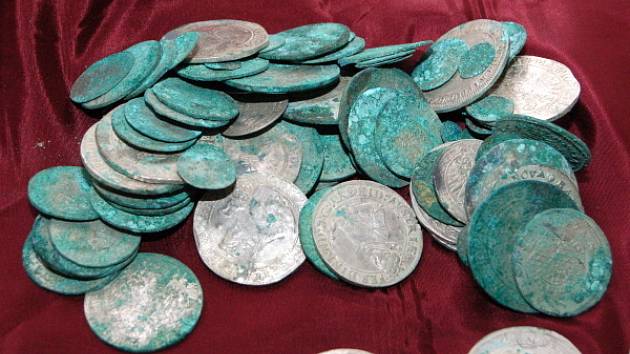V Kašperkách jsem byl několikrát na vejletě, hezké místo.
15. 4. 2009 Treasure from Kašperské Hory
Categories: Minting - Numismatics , Treasures , Finds and rescue research in the Czech Republic , Calendar
Archaeologists made a great discovery twelve years ago. During a survey in Kašperské Hory in the Klatovy region, they dug a pot full of hundreds of years old coins. In the end, the experts counted over three and a half thousand.
Specifically, they were three-krejcars, tailors and the smallest coins such as pennies or phoenixes. The coins were minted in mints in Saxony, Bavaria, Tyrol, Bohemia, Moravia, Silesia, Poland, the Netherlands and Switzerland. The pot was located at a depth of about sixty centimeters underground at the foundations of a historic building of old shops.
The oldest coin of the depot found was a Czech parvus with the name of Jan of Luxembourg, who ruled in the fourteenth century. The youngest then, the three-party trustee of Ferdinand II in Prague. from 1630. The coins were handled by experts from the Klatovy Museum, who cleaned and sorted them. The coin was covered with a thick layer of copper.
Photo gallery:
https://klatovsky.denik.cz/zpravy_region/fotogalerie-v-kasperskych-horach-nasli-poklad.html
Some coins were glued into lumps, which experts had to carefully peel off and only then remove the copper. Only then was it really possible to see what paintings and copies are on the embossments. "Cleaning such coins is difficult. It is not possible to use stronger chemicals. Coins could be irreparably damaged, "said numismatist Jiří Hána at the time.
The depot also contained several interesting coins. In addition to tolars, there were family, church or city mintings. Then there are the coins of Albrecht of Wallenstein or the three-quarters of Jindřich Šlik, which were minted in the mint in Planá near Mariánské Lázně. According to Hana, archaeologists rarely manage to discover such a mass coin find.
At first, archaeologists refused to divulge any details about the treasure. "We are afraid that we will tear down an avalanche of curious people who can destroy the archeological terrain," explained Karel Kašák, head of archaeological research at Archaia jih from Český Krumlov at the time.
The coin was probably hidden by a man who was afraid of looting mercenaries. He even used a cloth to seal the ceramic pot, which was used to hermetically close the containers. Archaeologists have found coins near the former mining shaft, which they had to examine to modernize the local square. The local town hall management was not very pleased, the work dragged on due to the finding.

Sources: www.novinky.cz, www.denik.cz, www.klatovy.cz
The article is included in categories:
- Archive of articles > Minting - Numismatics
- Archive of articles > Treasures
- Archive of articles > Archaeology > Finds and rescue research in the Czech Republic
- Archive of articles > Calendar
Post
A já se byl i podívat v muzeu na ten depot :-nejzajímavější tam byl 2 krejcar, maličká mince a přesto nejcennější z celého souboru.do té doby byla neznámá.. Doporučuju.. Dovolená to byla super.. 
Jo to byl nález.......ze lžíce bagru se začali sypat mince ........ 

A ja po tom šlapal celý život když jsem chodil nakoupit 😂😂😂😂😂😂😂








